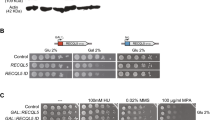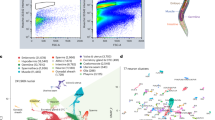Abstract
The X-linked Stellaterepeats, encoding a putative regulatory subunit of protein kinase CK2, are expressed in XO male testes. The Y-linked, testes-expressed paralogous Su(Ste) repeats are thought to be suppressors of Stellatetranscription. The unique, testis-expressed euchromatic gene was suggested to be an ancestor of the both types of amplified paralogous repeats. A Su(Ste)-like orphon was localized on a Y chromosome, outside of the Su(Ste) cluster. Several diagnostic molecular markers peculiar for the both types of diverged Stellateand Su(Ste) units were detected in the orphon sequence. The orphon was suggested to be a close relative of the immediate ancestor of both types of paralogous repeats which initiated evolution on the Y chromosome. Selection pressure on the level of translation was shown as a driving force in the evolution of Su(Ste) repeats, which are considered as more ancient derivatives of the ancestor euchromatic gene than Stellaterepeats. In a vicinity of 12E Stellatecluster the undamaged, recently originated euchromatic Stellateorphon was found at 12D, providing the poly(A) signal for the bendlessgene. P-element mediated transformations reveal that the fragments of cloned Stellateand Su(Ste) clusters are able to induce variegation of a reporter mini-whitegene. The observed variegation phenomenon has peculiar features: a significant increase of trans-activation of a reporter mini-whitegene in homozygous stat; absence of effects of several conventional modifiers of position effect variegation (PEV) and independence of a severity of variegation on a distance between insertion and centromere region.
Similar content being viewed by others
References
Akashi, H., 1997. Codon bias evolution in Drosophila. Population genetics of mutation-selection drift. Gene 205: 269–278.
Ashburner, M., 1989. Transvection effects, pp. 915–929 in Drosophila: A Laboratory Handbook. Cold Spring Harbor Press, Cold Spring Harbor, NY.
Balakireva, M.D., Yu.Ya. Shevelyov, D.I. Nurminsky, K.I. Livak & V.A. Gvozdev, 1992. Structural organization and diversification of Y-linked sequences comprising Su(Ste) genes in Drosophila melanogaster. Nucl. Acids Res. 20: 3731–3736.
Bozzetti, M., S. Massari, P. Finelli, F. Meggio, L.A. Pinna, B. Boldireff, O.-G. Issinger, G. Palumbo, C. Ciriaco, S. Bonaccorsi & S. Pimpinelli, 1995. The Stelocus, a component of the parasitic cry-Stesystem of Drosophila melanogaster, encodes a protein that forms crystals in primary spermatocytes and mimics properties of the b subunit of casein kinase 2. Proc. Natl. Acad. Sci. USA 92: 6067–6071.
Chantalat, L., D. Leroy, O. Filhol, A. Nueda, M. Benitez, E.M. Chambaz, C. Cochet & O. Dideberg, 1999. Crystal structure of the human protein kinase CK2 regulatory subunit reveals its zinc finger-mediated dimerization. EMBO J. 18: 2930–2940.
Charlesworth, B., 1996. The evolution of chromosomal sex determination and dosage compensation. Curr. Biol. 6: 149–162.
Cryderman, D.E., E.J. Morris, H. Biessmann, S.C.R. Elgin & L.L. Wallrath, 1999. Silencing at Drosophilatelomeres: nuclear organization and chromatin structure play critical roles. EMBO J. 18: 3724–3735.
Danilevskaya, O.N., E.V. Kurenova, M.N. Pavlova, D.V. Bebehov, A.J. Link, A. Koga, A. Vellek & D.L. Hartl, 1991. He-T family DNA sequences in the Y chromosome of Drosophila melanogastershare homology with the X-linked Stellategenes. Chromosoma 100: 118–124.
Dorer, D.R. & S. Henikoff, 1994. Expansion of transgene repeats cause heterochromatin formation and gene silencing in Drosophila. Cell 77: 993–1002.
Dorer, D.R. & S. Henikoff, 1997. Transgene repeat arrays interact with distant heterochromatin and cause silencing in cisand trans. Genetics 147: 1181–1190.
Fire, A., 1999. RNA-triggered gene silencing. Trends Genet. 15: 358–361.
Garrick, D., S. Fiering, D.I. Martin & E. Whitelaw, 1998. Repeat induced gene silencing in mammals. Nat. Genet. 18: 56–59.
Gatti, M. & S. Pimpinelli, 1992. Functional elements in Drosophila melanogasterheterochromatin. Adv. Genet. 26: 239–276.
Hardy, R.W., D.L. Lindsley, K.J. Livak, B. Lewis, A.L. Silverstein, G.L. Joslyn, J. Edwards, S. Bonaccorsi, 1984. Cytogenetic analysis of a segment of the Y chromosome of the Drosophila melanogaster. Genetics 107: 591–610.
Hurst, L.D., 1996. Further evidence consistent with Stellate's involvement in meiotic drive. Genetics 142: 541–643.
Hurst, L.D. & N.G.C. Smith, 1998. The evolution of concerted evolution. Proc. R. Soc. Lond. B. 265: 121–127.
Jensen, S., M.P. Gassama & T. Heidman, 1999. Taming of transposable elements by homology-dependent gene-silencing. Nat. Genet. 21: 209–212.
Kalmykova, A.I., A.A. Dobritsa & V.A. Gvozdev, 1997. The Su(Ste) repeat in the Y chromosome and βCK2tes gene encode predicted isoforms of regulatory β-subunit of protein kinase CK2 in Drosophila melanogaster. FEBS letters 416: 164–166.
Kalmykova, A.I., Y.Y. Shevelyov, A.A. Dobritsa & V.A. Gvozdev, 1997. Acquisition and amplification of a testis-expressed autosomal gene, SSL, by the DrosophilaY chromosome. Proc. Natl. Acad. Sci. USA 94: 6927–6302.
Kalmykova, A.I., A.A. Dobritsa & V.A. Gvozdev, 1998. Su(Ste) diverged tandem repeats in a Y chromosome of Drosophila melanogasterare transcribed and variously processed. Genetics 148: 243–249.
Kennerdell, J.R. & R.W. Carthew, 1998. Use of dsRNA-mediated genetic interference to demonstrate that frizzledand frizzled2 act in the wingless pathway. Cell 95: 1017–1026.
Leung, J., D.A.R. Sinclair, S. Hayashi, G.M. Tener & T.A. Grigliatti, 1991. Informational redundancy of tRNA ser4 and tRNA ser7 genes in Drosophila melanogasterand evidence for intergenic recombination. J. Mol. Biol. 219: 175–188.
Lewis, E.B., 1950. The phenomenon of position effect. Adv. Genet. 3: 73–115.
Lindsley, D.L. & G.G. Zimm, 1992. The genome of Drosophila melanogaster. Academic Press, San Diego, CA.
Livak, K.J., 1984. Organization and mapping of a sequence on the Drosophila melanogasterX and Y chromosomes that is transcribed during spermatogenesis. Genetics 107: 611–634.
Livak, K.J., 1990. Detailed structure of the Drosophila melanogaster Stellategenes and their transcripts. Genetics 124: 303–316.
Lohe, A.R. & A. Hilliker, 1995. Return to the H-word (heterochromatin). Curr. Opin. Genet. Dev. 5: 746–755.
Martin-Morris, L.E., A.K. Csink, D.R. Dorer, P.B. Talbert & S. Henikoff, 1997. Heterochromatic trans-inactivation of Drosophila whitetransgenes. Genetics 147: 671–677.
McKee, B. & M.T. Satter, 1996. Structure of the Y chromosomal Su(Ste) locus in Drosophila melanogasterand evidence for localized recombination among repeats. Genetics 142: 149–161.
Muralidhar, M.G. & J.B. Thomas, 1993. The Drosophila bendlessgene encodes a neural protein related to ubiquitin-conjugating enzymes. Neuron 11: 253–266.
Nassif, N. & W. Engels, 1993. DNA homology requirements for mitotic gap repair in Drosophila. Proc. Natl. Acad. Sci. USA 90: 1262–1266.
Oh, C.E., R. McMahon, S. Benzer & M.A. Tanouye, 1994. bendless, a Drosophilagene affecting neuronal connectivity, encodes a ubiquitin-conjugating enzyme homolog. J. Neurosci. 14: 3166–3179.
Olson, M.V., 1999. Molecular evolution 99.When less is more: gene loss as an engine of evolutionary change. Am. J. Hum. Genet. 64: 18–23.
Palumbo, G., M. Berloco, L. Fanti, M.P. Bozzetti, S. Massari, R. Caizzi, C. Caggese, L. Spinelli & S. Pimpinelli, 1994. Interaction systems between heterochromatin and euchromatin in Drosophila melanogaster. Genetica 94: 267–274.
Parniske, M., K.E. Hammond-Kosack, C. Goldstein, C.M. Thomas, D.N. Jones, K. Harrisson, B.B.H. Wulff & D.G. Jones, 1997. Novel disease resistance specificities result from sequence exchange between tandemly repeated genes at the Cf-4/9 locus of tomato. Cell 91: 821–832.
Pirrotta, V., 1997. Chromatin-silencing mechanism in Drosophilamaintain patterns of gene expression. Trends Genet. 13: 314–318.
Powell, J.R. & E.N. Moriyama, 1997. Evolution of codon usage bias in Drosophila. Proc. Natl. Acad. Sci. USA 94: 7784–7790.
Saxena, A., M. Carney, M. Bruley & C.V.C. Glover, 1989. Characterization of genes encoding the alpha and beta subunits of Drosophilacasein kinase II. Genetics 122: S25.
Schmidt, A., G. Palumbo, M.P. Bozetti, P. Tritto, S. Pimpinelli & U. Schafer, 1999. Genetic and molecular characterization of sting, a gene involved in crystal formation and meiotic drive in the male germ line of Drosophila melanogaster. Genetics 151: 749–760.
Sharp, P.M. & G. Matassi, 1994. Codon usage and genome evolution. Curr. Opin. Gen. Dev. 4: 851–860.
Shevelyov, Y.Y., M.D. Bala Kireva & V.A. Gvozdev, 1989. Heterochromatic regions in different Drosophila melanogasterstocks contains similar arrangements of moderate repeats with inserted copia-like elements (MDG1). Chromosoma 98: 117–122.
Shevelyov, Yu.Yu., 1992. Copies of a Stellategenes variant are located in the X heterochromatin of Drosophila melanogasterand are probably expressed. Genetics 132: 1033–1037.
Spofford, J.B., 1976. Position-effect variegation in Drosophila. In: M. Ashburner, E. Novitsky, The genetics and biology of Drosophila. Vol. 1C, pp. 955–1018. Acad Press, London, NY, San Francisco.
Steinemann, M. & S. Steinemann, 1998. Enigma of Y chromosome degeneration: neo-Y and neo-X chromosomes of Drosophila mirandaa model for sex chromosome evolution. Genetica 102–103: 409–420.
Tulin, A.V., G.L. Kogan, D. Filipp, M.D. Balakireva & V.A. Gvozdev, 1997. Heterochromatic Stellategene cluster in Drosophila melanogaster: structure and molecular evolution. Genetics 146: 253–262.
Tulin, A.V., N.M. Naumova, A.A. Aravin & V.A. Gvozdev, 1998. Repeated, protein-encoding heterochromatic genes cause inactivation of a juxtaposed euchromatic gene. FEBS Letters 425: 513–516.
Williams, S.M., G.R. Furnier, E. Fuog & C. Strobeck, 1987. Evolution of ribosomal DNA spacers of Drosophila melanogaster: different patterns of variation on X and Y chromosomes. Genetics 116: 225–232.
Zhimulev, I.F., 1998. Polytene chromosomes, heterochromatin and position effect variegation. Adv. Genet. 37: 1–566.
Author information
Authors and Affiliations
Rights and permissions
About this article
Cite this article
Gvozdev, V.A., Kogan, G.L., Tulin, A.A. et al. Paralogous Stellate. Genetica 109, 131–140 (2000). https://doi.org/10.1023/A:1026596419250
Issue Date:
DOI: https://doi.org/10.1023/A:1026596419250




